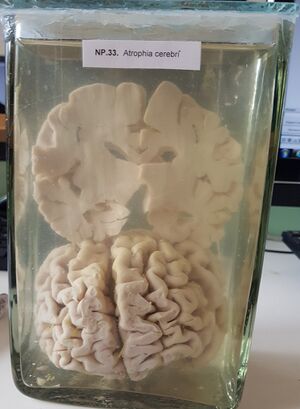16. Cerebral atrophy
Organ: Brain
Description:
The occipital lobe and a frontal slice of the brain can be seen. The sulci are wider than normal, and the gyri are narrower than normal. From the back you can see that the ventricles are also larger.
Diagnosis: Cerebral atrophy
Causes:
- Vascular encephalopathy (= Atherosclerosis of cerebral vessels)
- Alzheimer’s disease
- Huntington’s disease
- Multiple sclerosis
- Epilepsy
- Anorexia
Theory:
In addition to the sulci and gyri changes will an atrophic brain also have reduced weight. A reduction from the normal 1200g to below 1000g is a sign of atrophy.
